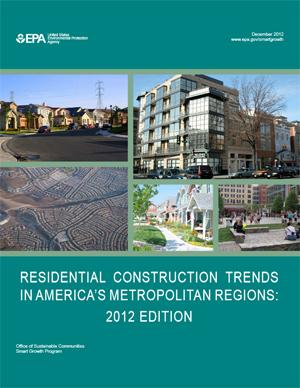
Residential Construction Trends in America's Metropolitan Regions: 2012 Edition compares the location of new homes to data about pre-existing land cover to determine where infill development was taking place in 209 U.S. metropolitan regions between 2000 and 2009. The findings affirm the overall conclusions of the previous two reports while painting a more geographically detailed picture of infill development trends.
This report finds that:
- Nearly three out of four large metropolitan regions saw an increased share of infill housing development in 2005-2009 compared to 2000-2004.
The report examined 51 large metropolitan regions (population 1 million or greater). Of those, 36 saw an increased share of infill housing development during 2005-2009 compared to 2000-2004. In many regions, this increase was dramatic. For example, Miami increased from 40 percent to 49 percent infill, and Providence, Rhode Island, increased from 20 percent to 29 percent.
- Infill accounted for one-fifth of new housing construction.
In the 209 metropolitan regions examined in this study, 21 percent of all new homes were built in previously developed areas. Northeastern metropolitan regions had the most infill construction, with 32 percent of all new housing units built in previously developed areas. In the South, infill accounted for 16 percent of new home construction.
- Infill residential development varied widely among metropolitan regions.
Eight out of 10 new homes in San Jose, California, were infill. New York, Los Angeles, and San Francisco all saw a majority of new home construction in previously developed areas during the same period. However, infill accounted for only 7 percent of new housing construction in Austin, Texas. In medium-sized regions, such as Prescott, Arizona, infill's share was as low as 2 percent.
- Infill is associated with higher home prices and rail transit investment.
Metropolitan regions that had a larger share of infill housing development tended to have higher median home sales prices, more miles of rail transit per capita, and higher transit ridership per capita.
- Nearly all metropolitan regions are growing outward more than they are growing inward.
During the later period of this analysis (2005 to 2009), infill as a share of new home construction exceeded 50 percent in only four metropolitan regions. The other 205 metropolitan regions were still growing outward faster than they were growing inward when measured on a per housing unit basis.
See the main Residential Construction Trends in America's Metropolitan Regions page for more context on these trends and links to earlier research.
You will need Adobe Reader to view some of the files on this page. See EPA’s About PDF page to learn more.